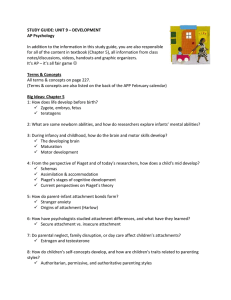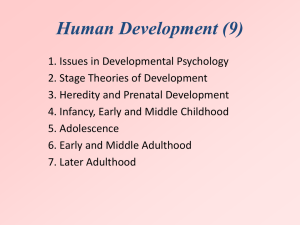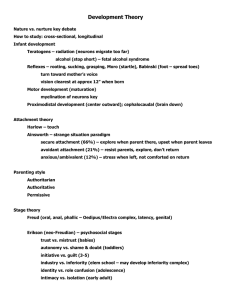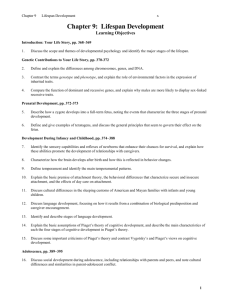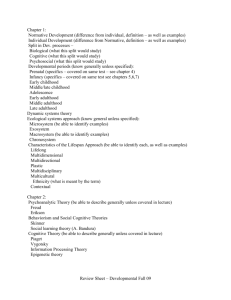Development Chapter 5
advertisement
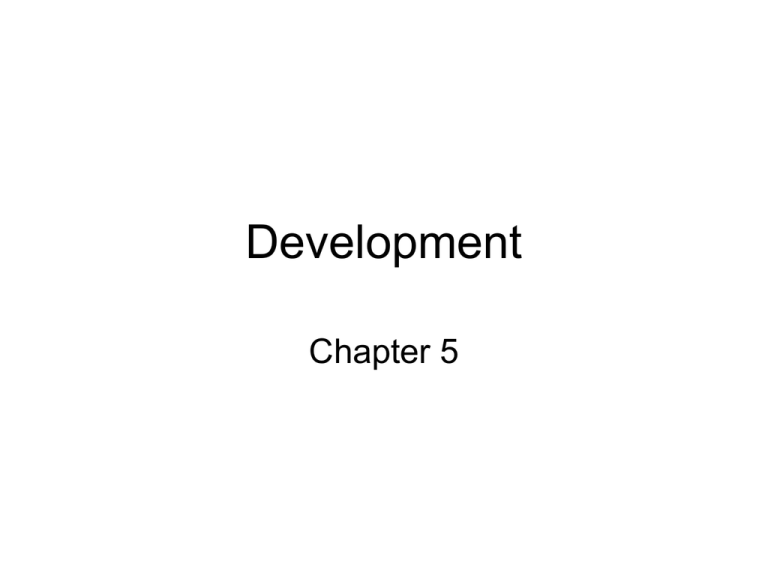
Development Chapter 5 Developmental Psychology • Study of the patterns of growth and change that occur throughout life Developmental Psychology Issue Nature/Nurture Continuity/Stages Stability/Change Details How do genetic inheritance (our nature) and experience (the nurture we receive) influence our behavior? Is development a gradual, continuous process or a sequence of separate stages? Do our early personality traits persist through life, or do we become different persons as we age. 3 Prenatal Development: Conception to Birth • The Earliest Development • 9 weeks looks human • 6 months point at which it can survive if born prematurely Prenatal Development: Conception to Birth • Prenatal Environmental Influences – Teratogens • • • • • Mother’s nutrition (especially lack of folic acid) Mother’s illness Mother’s emotional state Mother’s use of drugs Alcohol – Fetal alcohol syndrome (FAS) – Fetal alcohol effects (FAE) • Nicotine use The Extraordinary Newborn • Reflexes – Unlearned, involuntary responses that occur automatically in the presence of certain stimuli • • • • • Rooting reflex Sucking reflex Gag reflex Startle reflex Swallowing reflex The Extraordinary Newborn • Senses – All functional at birth, but vision is the least developed Early Brain Development • Large increase in numbers of neurons • Connections grow between the neurons • Pruning: the connections and neurons that are not used will die or become weakened • Myelination 8 Early Brain Development • Experience Shapes the Brain – brain structure and growth depends on genes and experiences 9 Early Brain Development • Implications for Caregivers – Early brain growth is rapid and reflects experience… • caressing a newborn, • talking to a preverbal infant – …are essential to develop that person’s full potential 10 Motor Development First, infants begin to roll over. Next, they sit unsupported, crawl, and finally walk. Experience has little effect on this sequence. Profimedia.CZ s.r.o./ Alamy Phototake Inc./ Alamy Images Jim Craigmyle/ Corbis Renee Altier for Worth Publishers 11 Maturation and Infant Memory The earliest age of conscious memory is around 3½ years (Bauer, 2002). 12 Cognitive Development Piaget believed that the driving force behind intellectual development is our biological development amidst experiences with the environment. Both photos: Courtesy of Judy DeLoache 13 Schemas Schemas are mental molds into which we pour our experiences. 14 Assimilation and Accommodation Bill Anderson/ Photo Researchers, Inc. Jean Piaget with a subject 15 Attachment • Harry Harlow’s study on attachment – “Wire monkey versus cloth monkey” http://www.youtube.com /watch?v=KlfOecrr6kI Figure 6 of Module 28 Attachment Differences Placed in a strange situation, 60% of children express secure attachment, i.e., they explore their environment happily in the presence of their mothers. When their mother leave, they show distress. The other 30% show insecure attachment. These children cling to their mothers or caregivers and are less likely to explore the environment. 17 Secure Attachment Relaxed and attentive caregiving becomes the backbone of secure attachment. Berry Hewlett 18 Deprivation of Attachment In such circumstances children become: 1. 2. 3. Withdrawn Frightened Unable to develop speech 19 Child-Rearing Practices Practice Description Authoritarian Parents impose rules and expect obedience. Permissive Parents submit to children’s demands. Authoritative Parents are demanding but responsive to their children. 20 Authoritative Parenting 21 Adolescence AP Photo/ Jeff Chiu 22 Physical Development Adolescence begins with puberty (sexual maturation). Puberty occurs earlier in females (11 years) than males (13 years). Thus height in females increases before males. 23 Frontal Cortex During adolescence, neurons in the frontal cortex grow myelin, which speeds up nerve conduction. The frontal cortex lags behind the limbic system’s development. Hormonal surges and the limbic system may explain occasional teen impulsiveness. 24 Cognitive Development Adolescents’ ability to reason gives them a new level of social awareness. In particular, they may think about the following: 1. 2. 3. 4. Their own thinking. What others are thinking. What others are thinking about them. How ideals can be reached. They criticize society, parents, and even themselves. 25 Developing Reasoning Power According to Piaget, adolescents can handle abstract problems. AP/Wide World Photos William Thomas Cain/ Getty Images 26 3 Basic Levels of Moral Thinking 1. 2. 3. Preconventional Morality: Conventional Morality: Postconventional Morality: 27 Forming an Identity In Western cultures, many adolescents try out different selves before settling into a consistent and comfortable identity. Having such an identity leads to forming close relationships. Matthias Clamer/ Getty Images Leland Bobble/ Getty Images 28 Emerging Adulthood Ariel Skelley/ Corbis 29 Adulthood Rick Doyle/ Corbis 30 Middle Adulthood Muscular strength, reaction time, sensory abilities and cardiac output begin to decline after the mid-twenties. Around age 50, women go through menopause, and men experience decreased levels of hormones and fertility. Bettman/ Corbis Batting performance of Willie Mays. 31 Old Age: Sensory Abilities Michael Newman/ PhotoEdit 32 Aging and memory • Normal healthy adults (even in the absence of disease) show age-related differences in performance on many cognitive tasks – Working memory – Episodic memory – Prospective memory – Executive functions Short term memory Long term memory for events Memory for future events A set of cognitive abilities that control and regulate other abilities and behaviors It’s not all downhill • Many cognitive functions are preserved with age such as: – Implicit memory – Semantic memory – Vocabulary Memory without consciousness of it Memory for facts Vocabulary Aging and Intelligence fluid intelligence (ability to reason speedily) declines with age, but crystalline intelligence (accumulated knowledge and skills) does not. We gain vocabulary and knowledge but lose recall memory and process more slowly. 35 Aging and Intelligence A number of cognitive abilities decline with age. However, vocabulary and general knowledge increase with age. 36 Adulthood’s Ages and Stages Is the mid-life crisis real? Neuroticism scores, 10,000 subjects (McCrae & Costa, 1996). 37 Adulthood’s Commitments Happiness stems from working in a job that fits your interests and provides you with a sense of competence and accomplishment. Charles Harbutt/ Actuality 38 Well-Being Across the Life Span Well-being and people’s feelings of satisfaction are stable across the life span. 39 Successful Aging 40 The Later Years of Life: Growing Old • The Social World of Late Adulthood: Old but Not Alone – Activity Theory of Aging Death and Dying Grief is more severe if death occurs unexpectedly. People who view their lives with a sense of integrity (in Erikson’s terms) see life as meaningful and worthwhile. Chris Steele-Perkins/ Magnum Photos 42
